A Case Study on Large Deformation Failure Mechanism and Control Techniques for Soft Rock Roadways in Tectonic Stress Areas
Abstract
:1. Introduction
2. Engineering Properties of the -415 Traveling Roadway
2.1. Engineering Setting
2.2. Rock Mass Properties
2.3. Large Deformation Failure of Weak Rock Tunnel
- (1)
- Large, non-uniform, and long-term duration deformation. Under the combined effects of tectonic stresses and surrounding rock collapse, the implemented roadway repair based on the “bolt–cable–mesh” support system presents no control on surrounding rock, as water saturation and weathering processes continue affecting extensively fractured surrounding rock mass. This leads to further weakening, swelling, and disintegration. Particularly in the middle roadway (60–80 m), floor heave is considerably severe, which is also accompanied by roof subsidence and sidewall shrinkage (Figure 6a). The roadway surrounding rock mass, with blocky structures and developed joints, collapses and presents large and uneven deformation. Moreover, the repair construction ends up with no control over the deformation of the roadway surrounding rock. The cross-section shape of the -415 traveling roadway after four months of continuous deformation is displayed in Figure 6b, with the contraction ratio through the whole roadway as high as 30–50%.
- (2)
- Supporting material failure. After being repaired using the “bolt–cable–mesh” support system, the roadway still maintains relatively fast deformation. Some support materials are damaged within three months of installation. The supporting process of roadway surrounding rock can be seen as the coupling process of unloading adjustment of the surrounding rock and support-based control and constraint. The coupling failure of rigidity and strength between the two is the major contributor to the support system’s destruction. Rock cables and bolts are extensively pulled and break up at the locker (Figure 6a), which suggests that the support system design does not specifically consider the large deformation instability mechanisms of the roadway during repair construction, and the resultant support system can no longer suppress the instability of the roadway surrounding rock.
3. Numerical Model Establishment
3.1. UDEC Trigon Approach
3.2. Deformable Block Model
3.3. Determination of Rock Mass Parameters
3.4. Numerical Model and Simulation Scheme for the -415 Traveling Roadway
4. Failure Mechanisms of Surrounding Rock in Numerical Simulation
4.1. Displacement Analysis
4.2. Stress Analysis
4.3. Crack and Plastic Zone Analysis
4.4. Failure Mechanism Analysis
- Contradiction between the complex in situ stress field and poor surrounding rock properties. The in situ stress field is a dominant factor characterizing the occurrence environment of the roadway, and the value, direction, and spatial distribution greatly impact the mechanical properties of the surrounding rock, the deformation failure of the support system and, ultimately, the stability of the roadway support engineering [48]. As the -415 traveling roadway obliquely penetrates through a syncline structure, the measured principal stress direction deflects from the roadway axis with certain angles, rather than coinciding with it, while the roadway is affected by many associated small faults. Hence, the in situ stress environment around the roadway is extremely complex, and such high and complex stress is a major challenge for the roadway support. Furthermore, the roadway surrounding integrity is compromised by the geological structures, which is embodied in the macroscopic scale as extensive development of cracks and greatly deteriorated rock mass mechanical properties. Moreover, the presence of muddy components such as kaolinite makes these cracks conduits for air and water intrusion, which leads to sustained weathering processes from shallow to deep. This further degrades the mechanical properties and self-stabilizing capacity of the surrounding rock. Once deviatoric stresses, formed by the free space of the roadway, exceed the shallow surrounding rock strength, plastic failure of rock mass and subsequent unloading occur [49], accompanied by massive associated cracks. This cyclic process integrating water saturation and weathering impacts, strength weakening, plastic failure, stress unloading, crack development, and then weathering of deeper surrounding rock continuously proceeds, and the failure zone correspondingly shifts from the shallow surrounding rock into deep areas. Under such circumstances, a contraction between the highly complex in situ stress field and the sustained property deterioration of surrounding rock comes into being.
- Misalignment between incomplete support and surrounding rock property deterioration. It is clear that the poor surrounding rock properties and their constant degrading were some of the major contributors to roadway destruction. The adopted roadway repair support system simply based on the general roadway support experience incorporates no specific measures to manage surrounding rock water saturation and weathering processes (i.e., shotcrete, etc.) and, therefore, can maintain roadway stability only shortly after support construction. Such misalignment between the incomplete support and sustained surrounding rock deterioration (driven by water saturation and weathering processes) results in an incapability of solving key problems that give rise roadway destruction and failure of the roadway support.
- No support for the roadway floor. The surrounding rock deterioration covers the whole roadway cross-section, which means that the floor rock mass has equal degrading potential compared to the rock mass at other positions. It should be noted that the roadway roof and floor maintain high stress concentration, from a mechanical point of view, which makes them vulnerable to surrounding rock control and prone to plastic instability. The support system to some extent improves the mechanical status and plastic failure proneness of the surrounding rock of the roadway roof and two sides. However, as property deterioration proceeds and shifts from shallow to deep, the importance of such improvements is highlighted by the outcome of a lack of floor support. The destruction of the surrounding rock at the roadway floor and the unfavorable stress status stimulate the loss of self-stabilizing capacity, and the floor heave deformation compromises the mechanical basis of the roadway side stability, leading to the destruction and instability of the two sides of the roadway from base to top.
5. The Combined Support Approach of “Bolt–Cable–Mesh–Shotcrete + Grouting”
5.1. Control Strategies
- Strengthening reinforcement and homogenization of surrounding rock. Tectonic and weathering processes compromise microscopic structures of the surrounding rock, while cracking, swelling, and crushing reduce its cohesion and strength. Therefore, the roadway surrounding rock generally presents mechanical characteristics of soft rock. Moreover, the uncertainty of joint growth in the inclined formation and the layered parallel distribution of discontinuities result in the macroscopic asymmetry deformation of the roadway. These sustained weakening processes eliminated the engineering basis for the active support mechanism of bolts, and failure to achieve equilibrium between the surrounding rock–bolt support structure and external pressure. Previous studies showed that, in the case of fully fractured surrounding rock, grouting is an effective approach to achieve homogenization and rigidity enhancement [50], able to improve the residual strength by 70–200%, which is also clear in Figure 8. Grouting can replace the role of muddy interstitial materials that become unconsolidated and debonded, while re-cementing the matrix and developing stable microscopic structures. In such cases, the surrounding rock mechanical properties are enhanced, and the self-stabilizing capacity is improved.
- Closing weathering passage. The uncontrollable weathering process of surrounding sandstones is one of the drivers for surrounding rock deterioration, and pre-existing cracks inside surrounding rock serve as passages for air and water intrusion. Grouting can not only strengthen surrounding rock, but also plug passages provided by cracks, effectively protecting deep sandstone from weathering damage. In addition, shotcrete over the full roadway surface can form a rigid protection layer to seal the surrounding rock and achieve a better protection performance.
- Coupling support composed of the support system and surrounding rock. The current incomplete roadway support incorporates no consideration for coupling with mechanical status evolution and vulnerable regions of the -415 traveling roadway surrounding rock, thus resulting in roadway instability. Given the premise of the fracturing and unloading status of roadway surrounding rock, this paper comprehensively takes into consideration the grouting reinforcement and flexible active support mechanism, which are essentially implemented using the high-strength pre-stressed bolt support and the rigid support mechanism of shotcrete. The effective support system should consider these aforementioned construction efforts, and incorporate both rigidity and flexibility, so as to control the roadway surrounding rock.
5.2. The Combined Support Approach
- Coupling support of pre-stressed bolts ad cables. High-strength Φ22 mm × 2000 mm bolts and Φ17.8 mm × 6300 mm pre-stressed cables are used, with row and column spacing of 700 mm × 700 mm and 1400 mm × 1400 mm, respectively. The high-density cables in the roof are mainly for the purpose of reinforcing roof rock mass prone to destruction. Bolts and cables are installed together with a steel mesh with a grid size of 100 mm × 100 mm. Then, a preliminary concrete layer with thickness of 50 mm is sprayed to preliminarily seal surrounding rock and suppress outward flow of grout. Bolts and cables are not pre-stressed when they are installed. After completion of grouting, pre-stresses of 60 kN and 120 kN are then applied to bolts and cables, respectively, to activate the active flexible support function of pre-stressed bolts.
- Surrounding rock grouting. Eight anchorage–grouting integrated high-strength grouting bolts of Φ22 mm × 2800 mm are installed in the roadway roof and two sides at the positions of original conventional bolts, as shown in Figure 17 (with row and column spacing of 1400 mm × 1400 mm). Such grouting bolts have tensile strengths of up to 600 MPa and can be installed using the same installation technique as conventional bolts, greatly improving the support strength and installation velocity. Six full-threaded grouting bolts of Φ22 mm × 1800 mm are installed in the floor, with row and column spacing of 700 mm × 1400 mm. The slurry of cement and water glass is selected as the grout material, with water cement ratios of 0.8/1–1/1 and slurry/water glass ratios equal to 1/0.03–1/0.05. The used cement is the conventional Portland Cement 425, the water glass modulus is 3, and the Baume degree is 40°. Since bolt support and preliminary shotcrete are constructed to constrain the radial displacement of surrounding rock prior to grouting, the grouting pressure is set as 6 MPa. The grouting completion criterion is that the single hole is filled with grout at the operating pressure and no more grout can be injected.
- High-strength shotcrete shell. Upon completion of grouting, the roadway roof is again sprayed with concrete to achieve a total layer thickness of 200 mm. The shotcrete strength is C20. An 816-mm double-layer steel reinforcement cage with spacing of 150 mm and grid size of 200 mm × 200 mm is installed on the roadway floor, onto which 300-mm-thick concrete is then poured. Thus, the rigid concrete support covering the full roadway surface is developed, which couples the surrounding rock grouting reinforcement and flexible pre-stressed support system into an integrated composite support system.
5.3. Numerical Validation of the “Bolt–Cable–Mesh–Shotcrete + Grouting” Combined Support Approach
5.4. Application to the -415 Traveling Roadway
6. Conclusions
Author Contributions
Funding
Acknowledgments
Conflicts of Interest
References
- National Bureau of Statistics of the People’s Republic of China. Statistical Bulletin on National Economic and Social Development in 2018; National Bureau of Statistics of the People’s Republic of China: Beijing, China, 2018.
- Yang, S.Q.; Chen, M.; Jing, H.W.; Chen, K.F.; Meng, B. A case study on large deformation failure mechanism of deep soft rock roadway in Xin’an coal mine, China. Eng. Geol. 2017, 217, 89–101. [Google Scholar] [CrossRef]
- Ma, C.Q.; Wang, P.; Jiang, L.S.; Wang, C.S. Deformation and control countermeasure of surrounding rocks for water-dripping roadway below a contiguous seam goaf. Processes 2018, 6, 77. [Google Scholar] [CrossRef]
- Vasarhelyi, B. Statistical analysis of the influence of water content on the strength of the miocene limestone. Rock Mech. Rock Eng. 2005, 38, 69–76. [Google Scholar] [CrossRef]
- Afrouz, A.; Harvey, J.M. Rheology of rocks within the soft to medium strength range. Int. J. Rock Mech. Min. Sci. Geomech. Abstr. 1974, 11, 281–290. [Google Scholar] [CrossRef]
- Van Eeckhout, E.M. The mechanisms of strength reduction due to moisture in coal mine shales. Int. J. Rock Mech. Min. Sci. Geomech. Abstr. 1976, 13, 61–67. [Google Scholar] [CrossRef]
- Dunning, J.; Douglas, B.; Miller, M.; McDonald, S. The role of the chemical environment in frictional deformation: Stress corrosion cracking and comminution. Pure Appl. Geophys. 1994, 143, 151–178. [Google Scholar] [CrossRef]
- Chugh, Y.P.; Missavage, R.A. Effects of moisture on strata control in coal mines. Eng. Geol. 1981, 17, 241–255. [Google Scholar] [CrossRef]
- Li, Q.H.; Shi, W.P.; Yang, R.S. Deformation mechanisms in a coal mine roadway in extremely swelling soft rock. SpringerPlus 2016, 5, 1310. [Google Scholar] [CrossRef]
- Sun, X.M.; Chen, F.; Miao, C.Y.; Song, P.; Li, G.; Zhao, C.W.; Xia, X. Physical modeling of deformation failure mechanism of surrounding rocks for the deep-buried tunnel in soft rock strata during the excavation. Tunn. Undergr. Space Technol. 2018, 74, 247–261. [Google Scholar] [CrossRef]
- Yuan, Y.; Wang, W.J.; Li, S.Q.; Zhu, Y.J. Failure mechanism for surrounding rock of deep circular roadway in coal mine based on mining-induced plastic zone. Adv. Civ. Eng. 2018, 2018, 1835381. [Google Scholar] [CrossRef]
- Tao, Z.G.; Zhu, C.; Zheng, X.H.; Wang, D.S.; Liu, Y.P.; He, M.C.; Wang, Y.B. Failure mechanisms of soft rock roadways in steeply inclined layered rock formations. Geomat. Nat. Hazards Risk 2018, 9, 1186–1206. [Google Scholar] [CrossRef] [Green Version]
- Nikolic, M.; Karavelic, E.; Ibrahimbegovic, A.; Miscevic, P. Lattice element models and their peculiarities. Arch. Comput. Methods Eng. 2018, 25, 753–784. [Google Scholar] [CrossRef]
- Boon, C.W.; Houlsby, G.T.; Utili, S. Designing tunnel support in jointed rock masses via the DEM. Rock Mech. Rock Eng. 2015, 48, 603–632. [Google Scholar] [CrossRef]
- Nikolic, M.; Ibrahimbegovic, A. Rock mechanics model capable of representing initial heterogeneities and full set of 3D failure mechanisms. Comput. Meth. Appl. Mech. Eng. 2015, 290, 209–227. [Google Scholar] [CrossRef]
- Ergenzinger, C.; Seifried, R.; Eberhard, P. A discrete element model to describe failure of strong rock in uniaxial compression. Granul. Matter 2011, 13, 341–364. [Google Scholar] [CrossRef]
- Nikolic, M.; Ibrahimbegovic, A.; Miscevic, P. Discrete element model for the analysis of fluid-saturated fractured poro-plastic medium based on sharp crack representation with embedded strong discontinuities. Comput. Meth. Appl. Mech. Eng. 2016, 298, 407–427. [Google Scholar] [CrossRef]
- Zheng, W.X.; Zhao, Y.L.; Bu, Q.W. The coupled control of floor heave based on a composite structure consisting of bolts and concrete antiarches. Math. Probl. Eng. 2018, 2018, 3545423. [Google Scholar] [CrossRef]
- Yu, W.J.; Liu, F.F. Stability of close chambers surrounding rock in deep and comprehensive control technology. Adv. Civ. Eng. 2018, 2018, 6275941. [Google Scholar] [CrossRef]
- Zhang, W.; He, Z.M.; Zhang, D.S.; Qi, D.H.; Zhang, W.S. Surrounding rock deformation control of asymmetrical roadway in deep three-soft coal seam: A case study. J. Geophys. Eng. 2018, 15, 1917–1928. [Google Scholar] [CrossRef]
- Kang, H.P.; Lin, J.; Fan, M.J. Investigation on support pattern of a coal mine roadway within soft rocks—A case study. Int. J. Coal Geol. 2015, 140, 31–40. [Google Scholar] [CrossRef]
- He, M.C.; Gong, W.L.; Wang, J.; Qi, P.; Tao, Z.G.; Du, S.; Peng, Y.Y. Development of a novel energy-absorbing bolt with extraordinarily large elongation and constant resistance. Int. J. Rock Mech. Min. Sci. 2014, 67, 29–42. [Google Scholar] [CrossRef]
- Chen, S.; Wu, A.; Wang, Y.; Chen, X.; Yan, R.; Ma, H. Study on repair control technology of soft surrounding rock roadway and its application. Eng. Fail. Anal. 2018, 92, 443–455. [Google Scholar] [CrossRef]
- Salimian, M.H.; Baghbanan, A.; Hashemolhosseini, H.; Dehghanipoodeh, M.; Norouzi, S. Effect of grouting on shear behavior of rock joint. Int. J. Rock Mech. Min. Sci. 2017, 98, 159–166. [Google Scholar] [CrossRef]
- Li, Q.H.; Yang, R.S.; Li, J.K.; Wang, H.; Wen, Z.J. Strength and cost analysis of new steel sets as roadway support project in coal mines. Adv. Mater. Sci. Eng. 2018, 2018, 3927843. [Google Scholar] [CrossRef]
- Yang, R.S.; Li, Q.H.; Li, Q.; Zhu, X.L. Assessment of bearing capacity and stiffness in new steel sets used for roadway support in coal mines. Energies 2017, 10, 16. [Google Scholar] [CrossRef]
- Wang, H.; Zheng, P.Q.; Zhao, W.J.; Tian, H.M. Application of a combined supporting technology with U-shaped steel support and anchor-grouting to surrounding soft rock reinforcement in roadway. J. Cent. South Univ. 2018, 25, 1240–1250. [Google Scholar] [CrossRef]
- Wu, A.X.; Chen, S.M.; Wang, Y.M.; Chen, X. Failure mechanism and supporting measures for large deformation of soft rock roadway in Baluba copper mine. Arch. Min. Sci. 2018, 63, 449–464. [Google Scholar]
- Sun, X.; Wang, L.; Lu, Y.; Jiang, B.; Li, Z.; Zhang, J. A yielding bolt-grouting support design for a soft-rock roadway under high stress: A case study of the Yuandian No. 2 coal mine in china. J. S. Afr. Inst. Min. Met. 2018, 118, 71–82. [Google Scholar] [CrossRef]
- Wang, Q.; Jiang, B.; Pan, R.; Li, S.C.; He, M.C.; Sun, H.B.; Qin, Q.; Yu, H.C.; Luan, Y.C. Failure mechanism of surrounding rock with high stress and confined concrete support system. Int. J. Rock Mech. Min. Sci. 2018, 102, 89–100. [Google Scholar] [CrossRef]
- Fairhurst, C.E.; Hudson, J.A. Draft ISRM suggested method for the complete stress-strain curve for intact rock in uniaxial compression. Int. J. Rock Mech. Min. Sci. 1999, 36, 279–286. [Google Scholar]
- Yao, Q.L.; Li, X.H.; Zhou, J.; Ju, M.H.; Chong, Z.H.; Zhao, B. Experimental study of strength characteristics of coal specimens after water intrusion. Arab. J. Geosci. 2015, 8, 6779–6789. [Google Scholar] [CrossRef]
- Fang, X.Q.; Xue, G.Z.; Liang, M.F.; Wang, G.; Fan, H.L. Micro-failure mechanism and bolt-grouting reinforcement support technology of water-bearing sandstone roadway. J. China Univ. Min. Technol. 2014, 43, 561–568. [Google Scholar]
- Yang, X.J.; Wang, E.Y.; Wang, Y.J.; Gao, Y.B.; Wang, P. A study of the large deformation mechanism and control techniques for deep soft rock roadways. Sustainability 2018, 10, 1100. [Google Scholar] [CrossRef]
- Gurocak, Z. Analyses of stability and support design for a diversion tunnel at the Kapikaya dam site, Turkey. Bull. Eng. Geol. Environ. 2011, 70, 41–52. [Google Scholar] [CrossRef]
- Sonmez, H.; Gokceoglu, C.; Ulusay, R. Indirect determination of the modulus of deformation of rock masses based on the GSI system. Int. J. Rock Mech. Min. Sci. 2004, 41, 849–857. [Google Scholar] [CrossRef]
- Ajalloeian, R.; Mohammadi, M. Estimation of limestone rock mass deformation modulus using empirical equations. Bull. Eng. Geol. Environ. 2013, 73, 541–550. [Google Scholar] [CrossRef]
- Hoek, E.; Marinos, P.; Benissi, M. Applicability of the geological strength index (GSI) classification for very weak and sheared rock masses. The case of the Athens Schist Formation. Bull. Eng. Geol. Environ. 1998, 57, 151–160. [Google Scholar] [CrossRef]
- Hoek, E.; Carranza-Torres, C.; Corkum, B. Hoek–Brown failure criterion–2002 edition. In Proceedings of the Fifth North American Rock Mechanics Symposium, Toronto, ON, Canada, 2002; pp. 267–273. [Google Scholar]
- Sonmez, H.; Ulusay, R. A discussion on the Hoek-Brown failure criterion and suggested modifications to the criterion verified by slope stability case studies. Bull. Earth Sci. Appl. Res. Cent. Hacet. Univ. 2002, 26, 77–99. [Google Scholar]
- Gao, F.Q.; Stead, D. The application of a modified Voronoi logic to brittle fracture modelling at the laboratory and field scale. Int. J. Rock Mech. Min. Sci. 2014, 68, 1–14. [Google Scholar] [CrossRef]
- Gao, F.Q.; Stead, D.; Coggan, J. Evaluation of coal longwall caving characteristics using an innovative UDEC trigon approach. Comput. Geotech. 2014, 55, 448–460. [Google Scholar] [CrossRef]
- Gao, F.Q.; Stead, D.; Kang, H.P. Simulation of roof shear failure in coal mine roadways using an innovative UDEC trigon approach. Comput. Geotech. 2014, 61, 33–41. [Google Scholar] [CrossRef]
- Itasca Consulting Group, Inc. Udec User Man; Itasca Consulting Group, Inc.: Minneapolis, MN, USA, 2008. [Google Scholar]
- Yang, S.Q.; Jing, H.W.; Wang, S.Y. Experimental investigation on the strength, deformability, failure behavior and acoustic emission locations of red sandstone under triaxial compression. Rock Mech. Rock Eng. 2012, 45, 583–606. [Google Scholar] [CrossRef]
- Yang, S.Q. An experimental study on fracture coalescence characteristics of brittle sandstone specimens combined various flaws. Geomech. Eng. 2015, 8, 541–557. [Google Scholar] [CrossRef]
- Diederichs, M.S.; Kaiser, P.K.; Eberhardt, E. Damage initiation and propagation in hard rock during tunnelling and the influence of near-face stress rotation. Int. J. Rock Mech. Min. Sci. 2004, 41, 785–812. [Google Scholar] [CrossRef]
- He, M.C.; Wang, X.Y.; Liu, W.T.; Yang, S.B. Numerical simulation on asymmetric deformation of deep soft rock roadway in Kongzhuang coal mine. Chin. J. Rock Mech. Eng. 2008, 27, 673–678. [Google Scholar]
- Shen, W.L.; Wang, X.Y.; Bai, J.B.; Li, W.F.; Yu, Y. Rock stress around noncircular tunnel: A new simple mathematical method. Adv. Appl. Math. Mech. 2017, 9, 1330–1346. [Google Scholar] [CrossRef]
- Narayaman, R.; Palanjing, A. Factors influencing the strength of steel fiber reinforced concrete. Dev. Fiber Reinf. Cem. Concr. 1986, 2, 1–8. [Google Scholar]
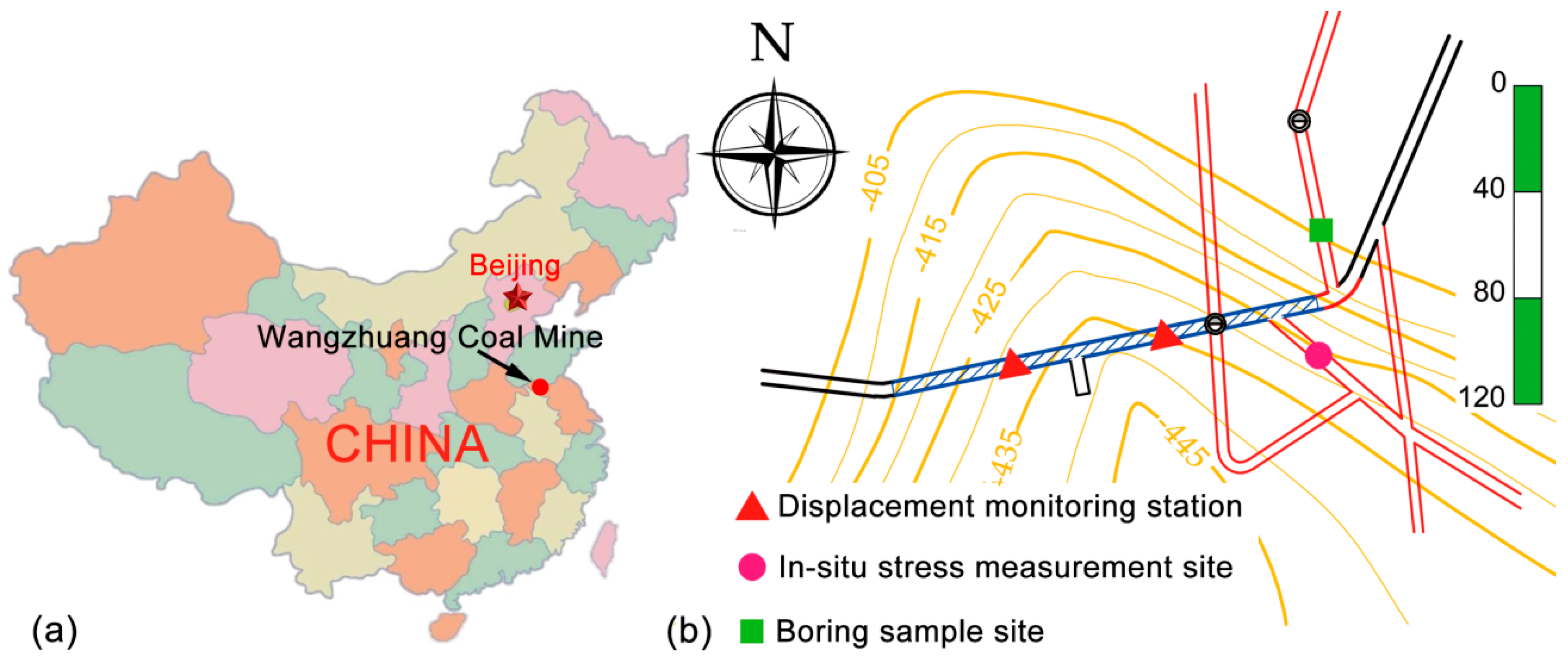
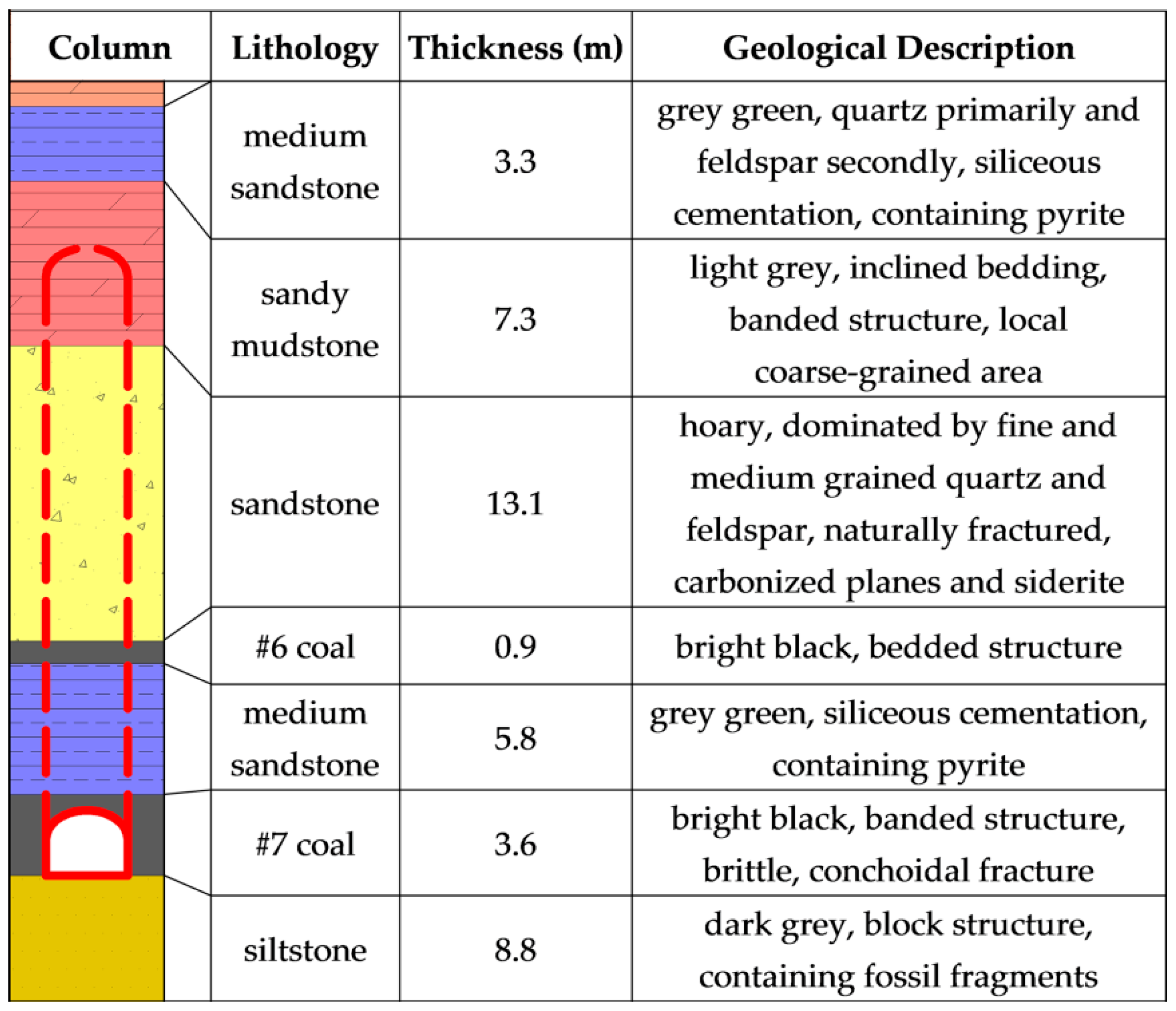
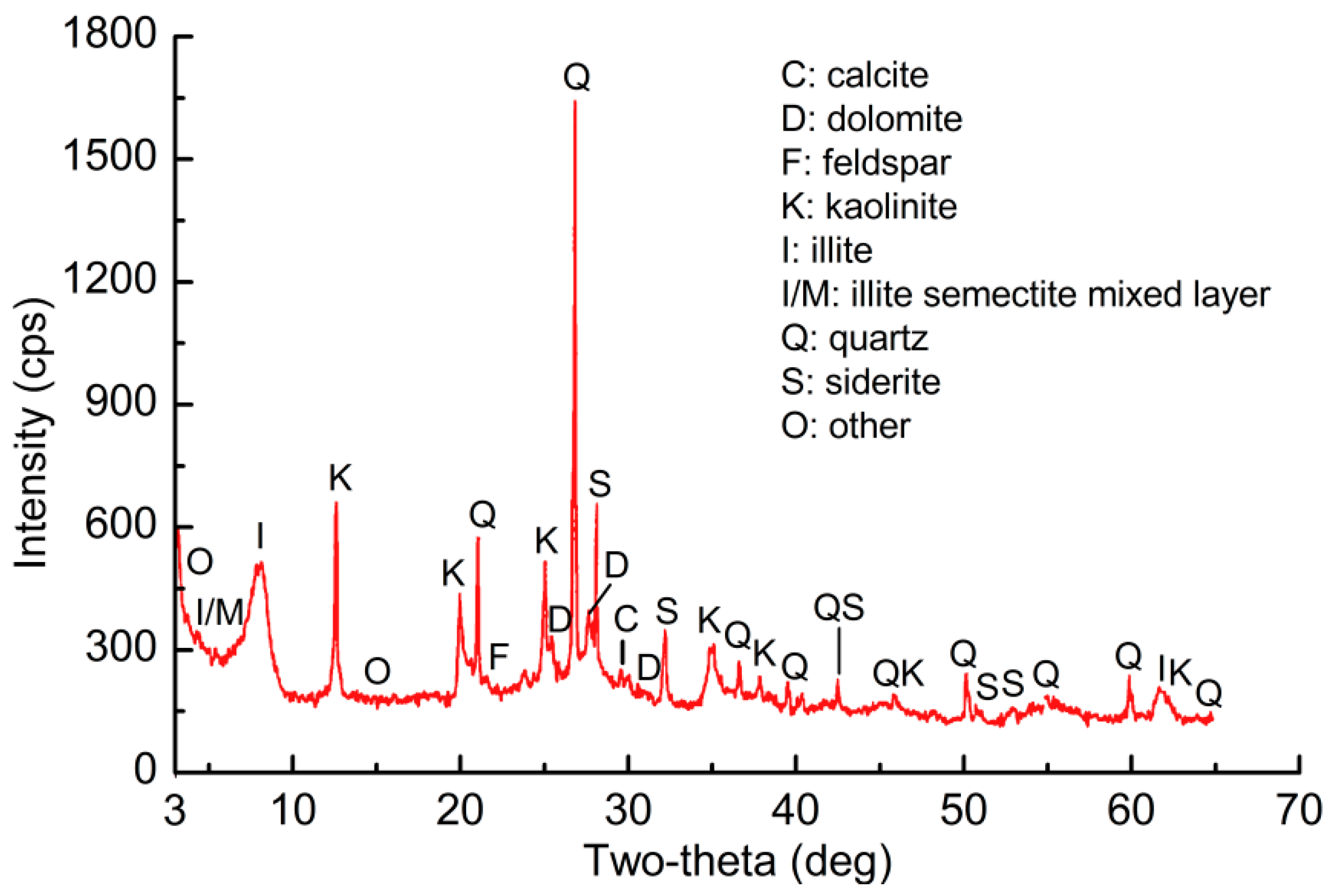





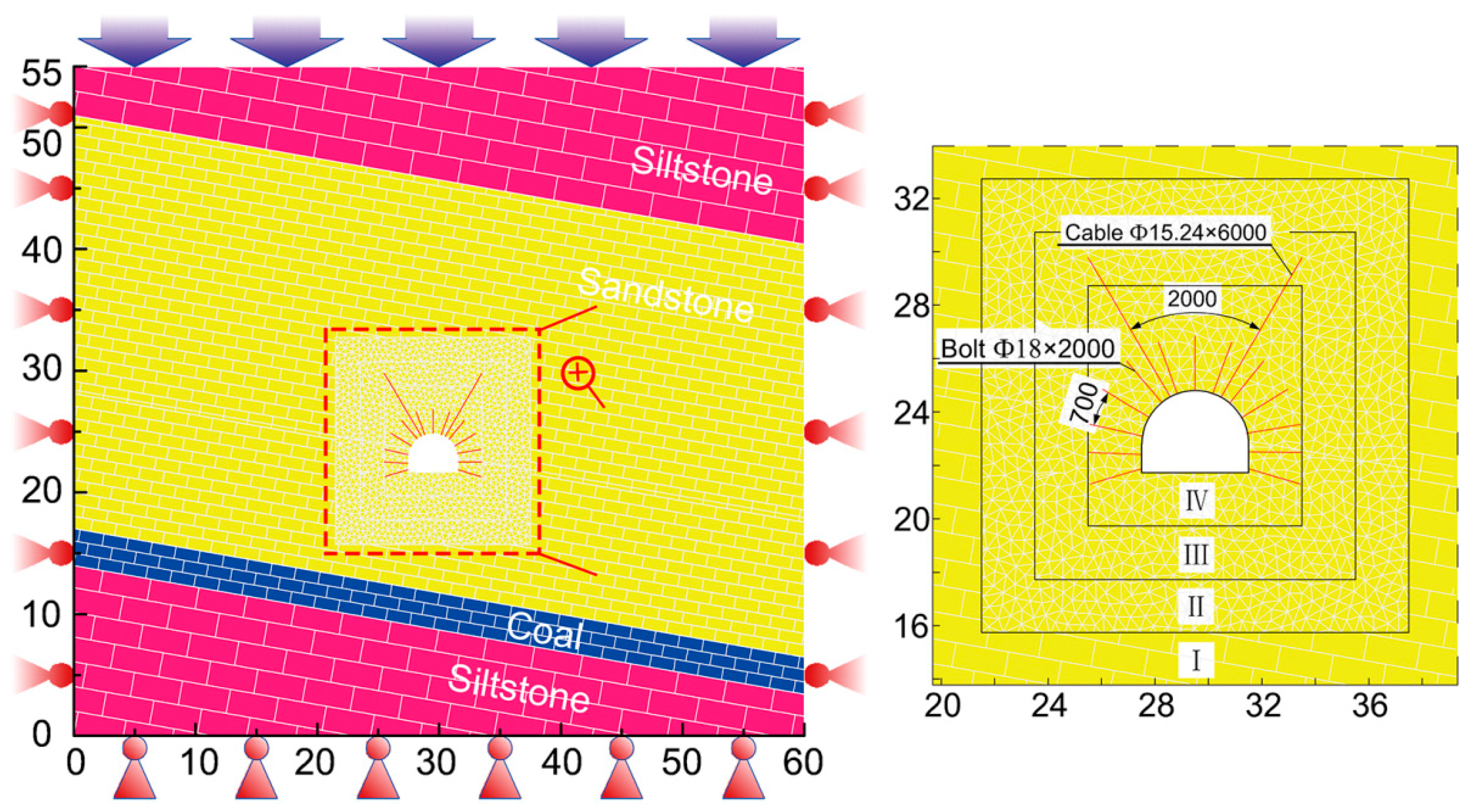

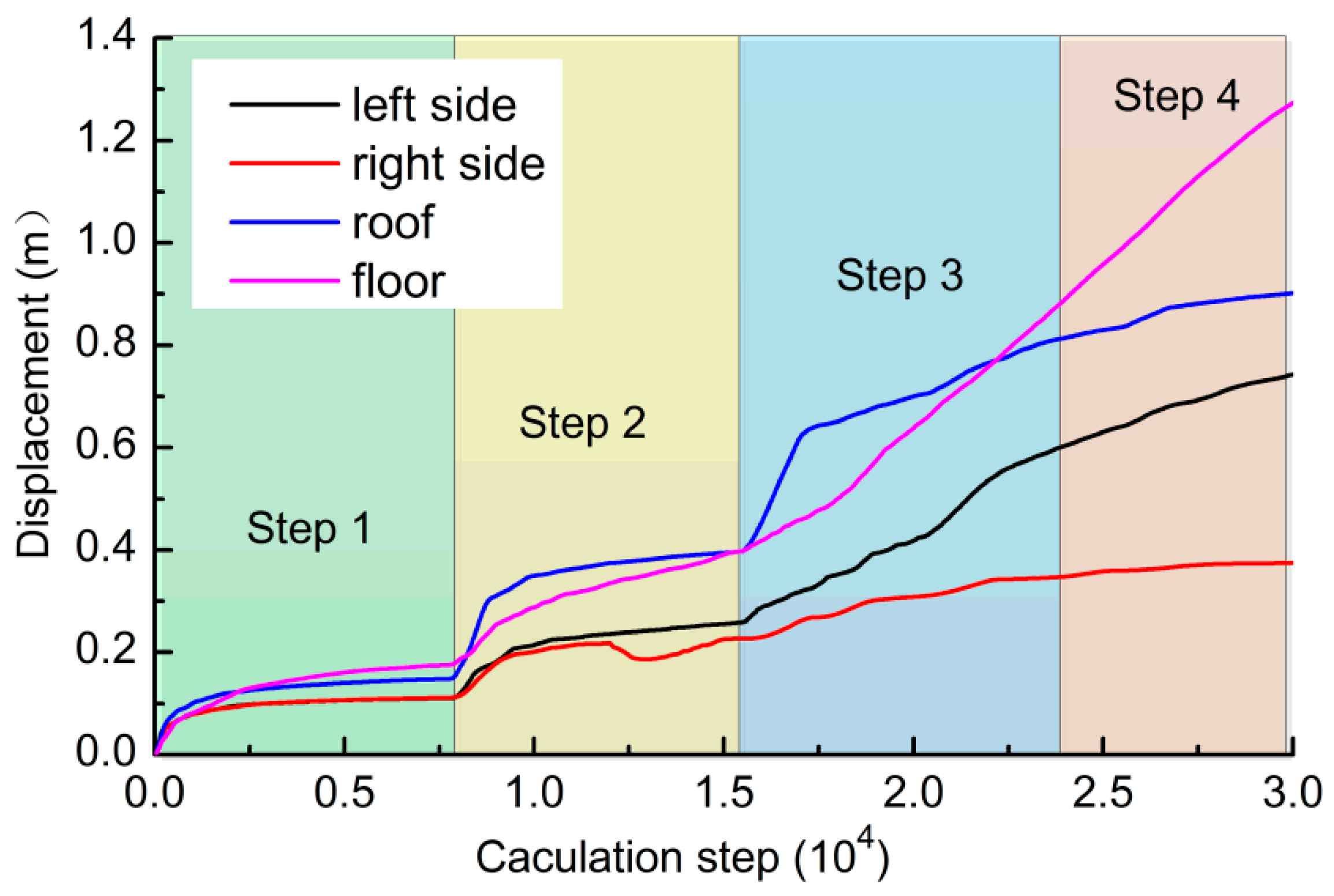



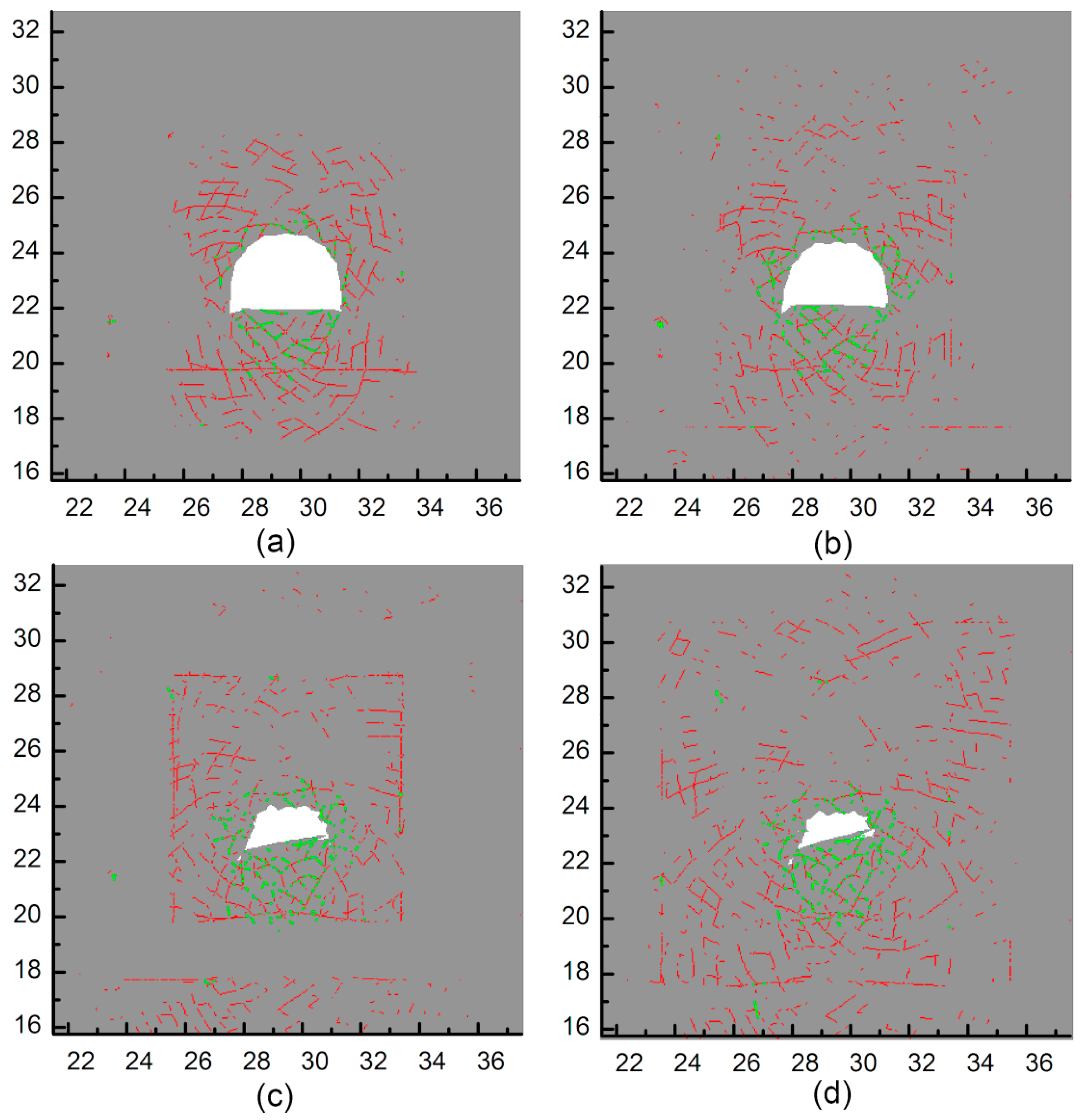
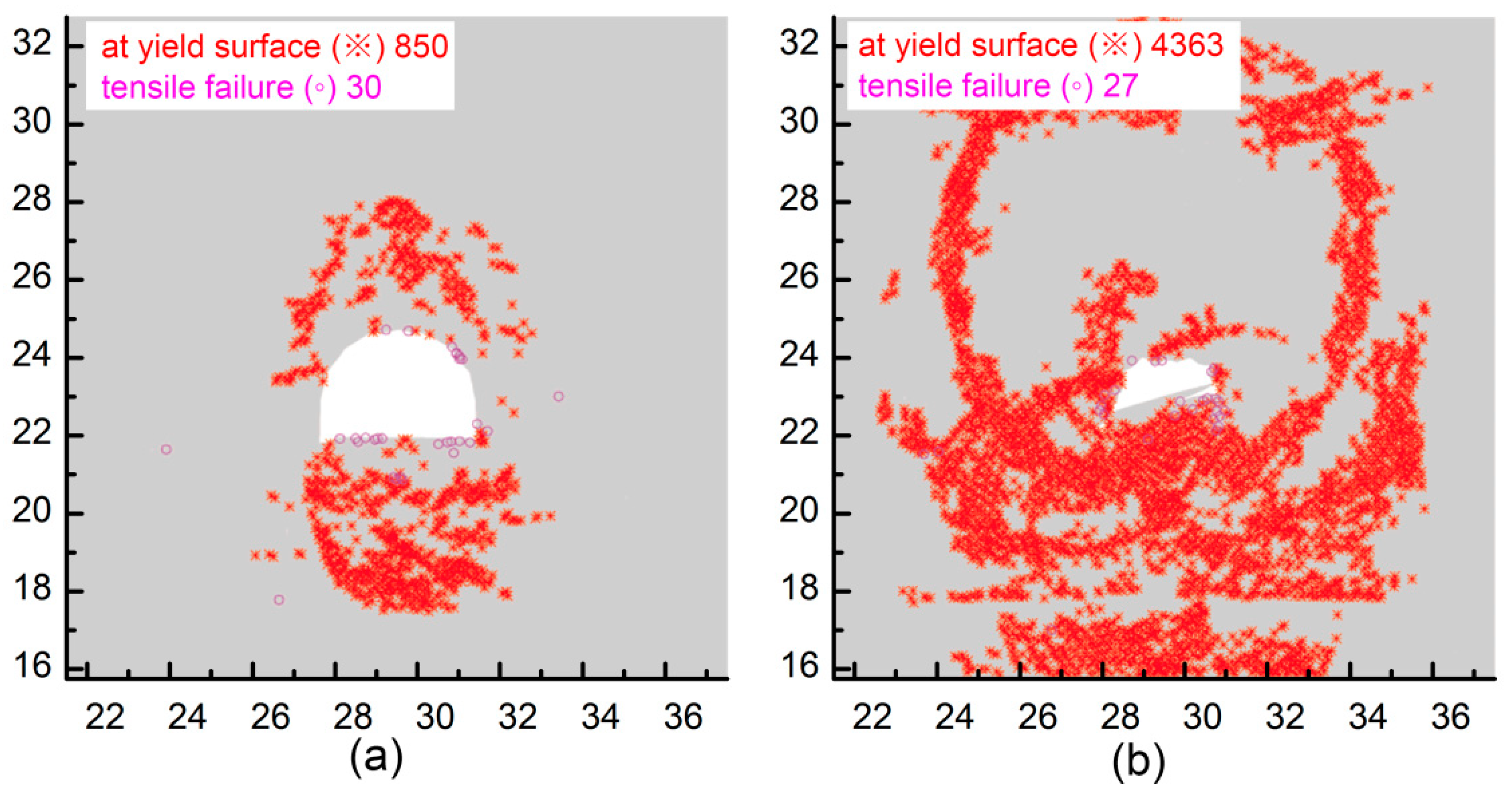

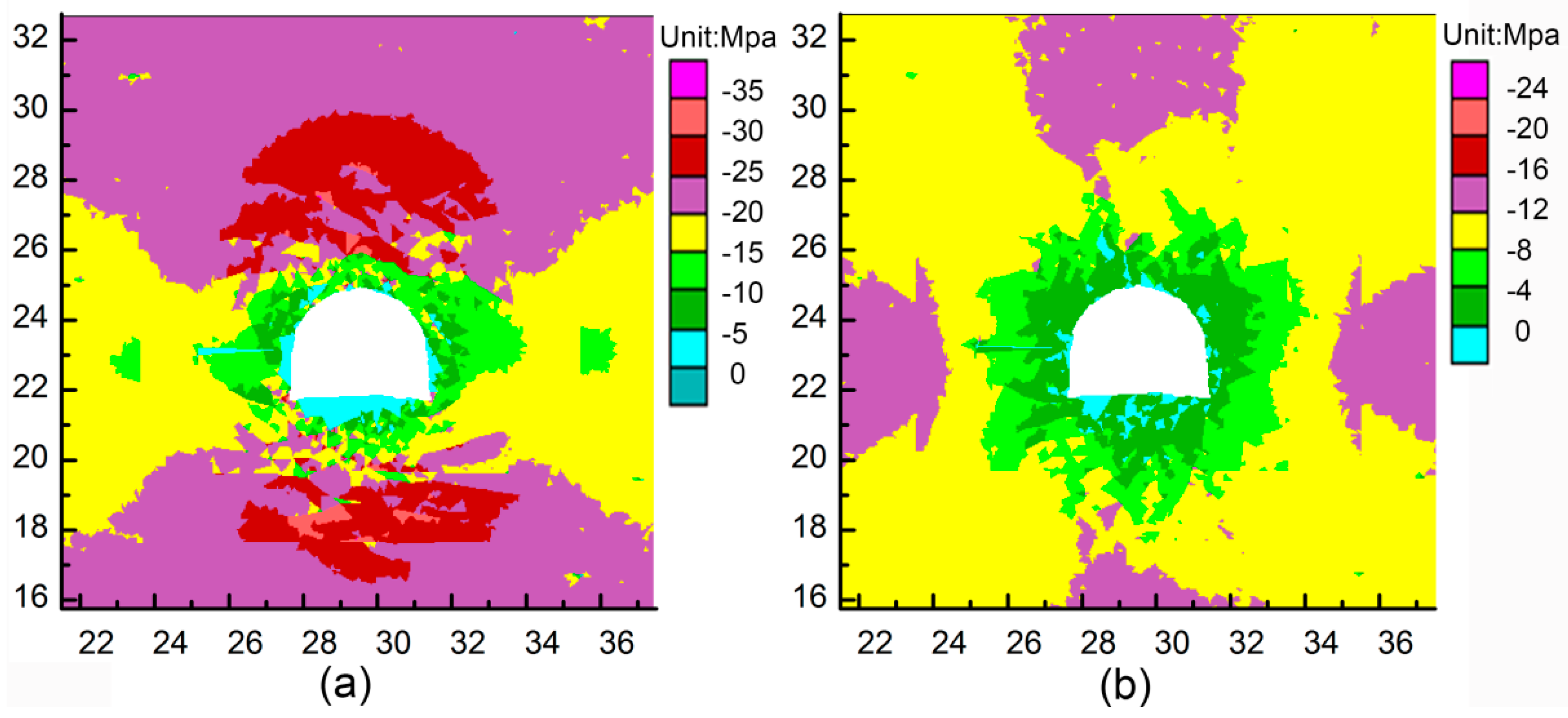
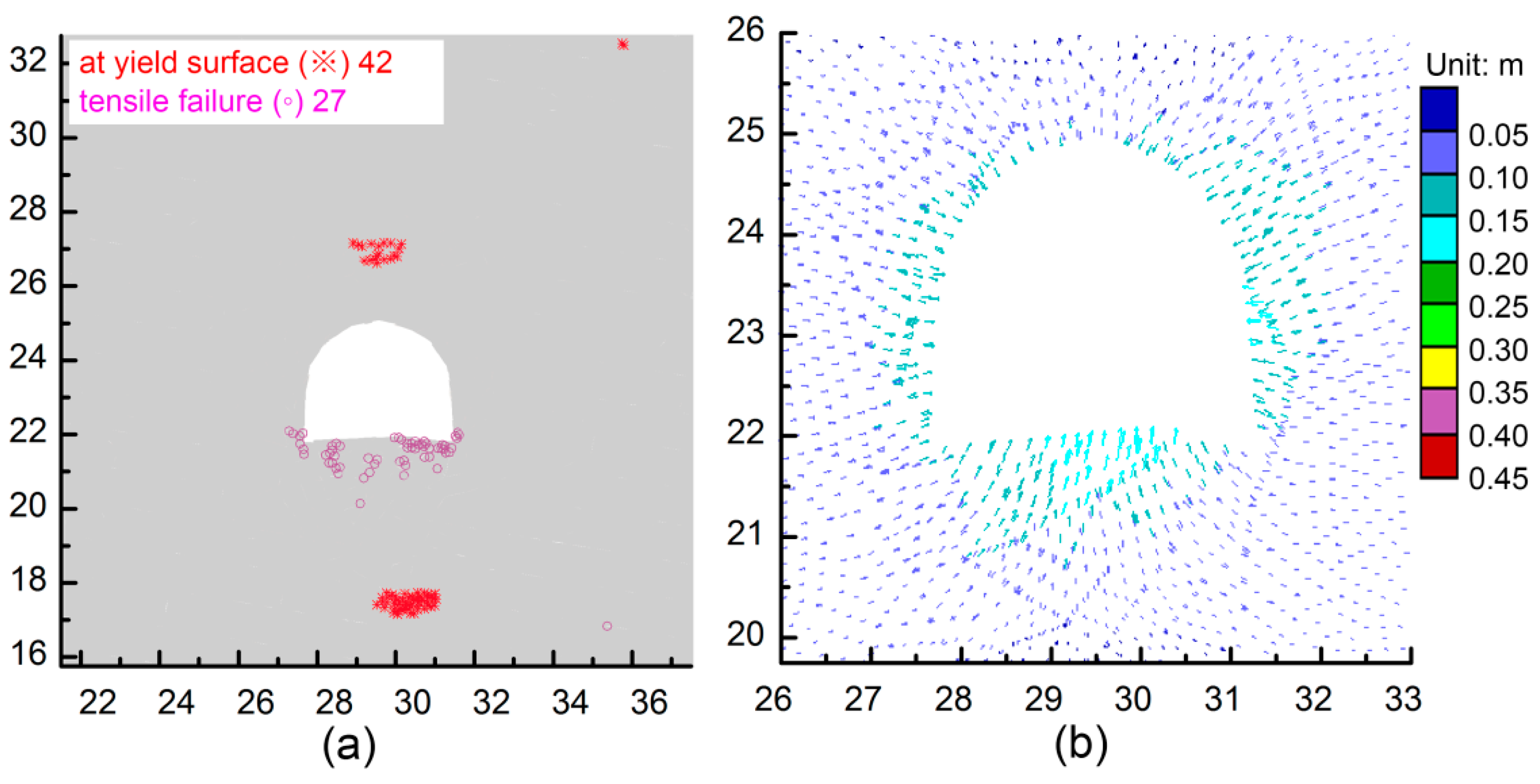

| Lithology | Intact Rock | GSI | Constant | Rock mass | ||||||
|---|---|---|---|---|---|---|---|---|---|---|
| σci (MPa) | μ | mi | D | mb | s (10−5) | a | σcmass (MPa) | Emass (MPa) | ||
| Siltstone | 10.75 | 0.27 | 42 | 8 | 0.6 | 0.4149 | 31.73 | 0.5099 | 3.82 | 1.69 |
| Sandstone | 14.6 | 0.24 | 40 | 5.14 | 0.6 | 0.2407 | 24.04 | 0.5114 | 2.81 | 1.29 |
| Water-saturated sandstone | 4.656 | 0.244 | 38 | 3 | 0.7 | 0.0543 | 2.54 | 0.5273 | 1.22 | 0.70 |
| Weathered sandstone | 1.923 | 0.245 | 27 | 0.015 | 0.9 | 1.31 × 10−4 | 0.93 | 0.5273 | 0.70 | 0.20 |
| 7# coal | 5.24 | 0.25 | 30 | 3 | 0.6 | 0.0843 | 5.99 | 0.5223 | 1.32 | 0.51 |
| Lithology | Properties of blocks | Properties of Contacts | |||||||||
|---|---|---|---|---|---|---|---|---|---|---|---|
| Density (kg/m3) | K (GPa) | G (GPa) | Cb (MPa) | φb (°) | σtb (MPa) | kn (GPa) | ks (GPa) | Cj (MPa) | φj (°) | σtj (MPa) | |
| Siltstone | 2650 | 1.082 | 0.6809 | 1.72 | 30 | 1.3 | 159.218 | 63.6876 | 0.9 | 30 | 0.26 |
| Sandstone | 2700 | 0.827 | 0.520 | 1.3 | 25 | 0.8 | 121.764 | 48.706 | 0.8 | 25 | 0.2 |
| Water-saturated sandstone | 2620 | 0.451 | 0.283 | 0.76 | 21 | 0.74 | 66.319 | 26.528 | 0.33 | 23 | 0.14 |
| Weathered sandstone | 1360 | 0.1301 | 0.082 | 0.2 | 19 | 0.38 | 19.146 | 7.658 | 0.21 | 19 | 0.1 |
| #7 coal | 1400 | 0.325 | 0.204 | 0.785 | 25 | 1 | 47.806 | 19.122 | 0.356 | 25 | 0.2 |
| Grouting sandstone | 2940 | 0.835 | 0.525 | 0.958 | 21 | 1.7 | 122.865 | 49.146 | 0.657 | 22 | 0.16 |
| Parameters | Density (kg/m3) | Young’s Modulus (GPa) | Tensile Yield Force (kN) | Bond Strength (N/m) | Bond Stiffness (N/m2) |
|---|---|---|---|---|---|
| Bolt | 7500 | 200 | 140 | 4 × 105 | 2 × 109 |
| Cable | 7500 | 200 | 320 | 4 × 105 | 2 × 109 |
| Parameters | Density (kg/m3) | Elastic moduli (GPa) | Tensile capability (kN) | Bond Strength (N/m) | Bond Stiffness (N/m2) | Pretension (kN) |
|---|---|---|---|---|---|---|
| Bolt | 7500 | 200 | 140 | 4e5 | 2e9 | 60 |
| Cable | 7500 | 200 | 300 | 4e5 | 2e9 | 120 |
| Grouting bolts in roof | 7500 | 200 | 127 | 4e5 | 2e9 | 60 |
| Grouting bolts in floor | 7500 | 200 | 80 | 4e5 | 2e9 | 0 |
| Parameters | Thickness (mm) | Elastic Moduli (GPa) | Compressive Strength (MPa) | Tensile Strength (MPa) | Contact Normal Stiffness (GPa/m) | Contact Shear Stiffness (GPa/m) |
|---|---|---|---|---|---|---|
| Shotcrete in roof | 200 | 25 | 70 | 50 | 10 | 10 |
| Concrete in floor | 300 | 35 | 150 | 100 | 20 | 20 |
© 2019 by the authors. Licensee MDPI, Basel, Switzerland. This article is an open access article distributed under the terms and conditions of the Creative Commons Attribution (CC BY) license (http://creativecommons.org/licenses/by/4.0/).
Share and Cite
Xue, G.; Gu, C.; Fang, X.; Wei, T. A Case Study on Large Deformation Failure Mechanism and Control Techniques for Soft Rock Roadways in Tectonic Stress Areas. Sustainability 2019, 11, 3510. https://doi.org/10.3390/su11133510
Xue G, Gu C, Fang X, Wei T. A Case Study on Large Deformation Failure Mechanism and Control Techniques for Soft Rock Roadways in Tectonic Stress Areas. Sustainability. 2019; 11(13):3510. https://doi.org/10.3390/su11133510
Chicago/Turabian StyleXue, Guangzhe, Chao Gu, Xinqiu Fang, and Tao Wei. 2019. "A Case Study on Large Deformation Failure Mechanism and Control Techniques for Soft Rock Roadways in Tectonic Stress Areas" Sustainability 11, no. 13: 3510. https://doi.org/10.3390/su11133510




